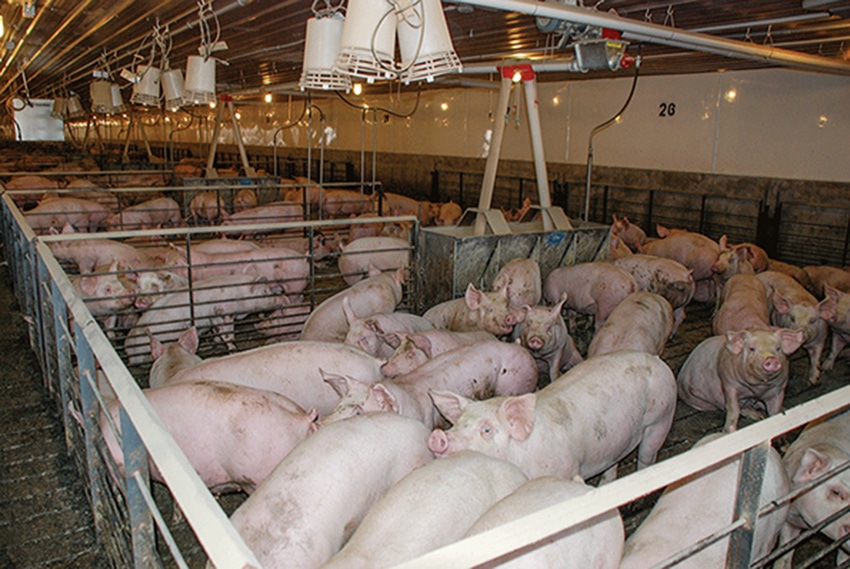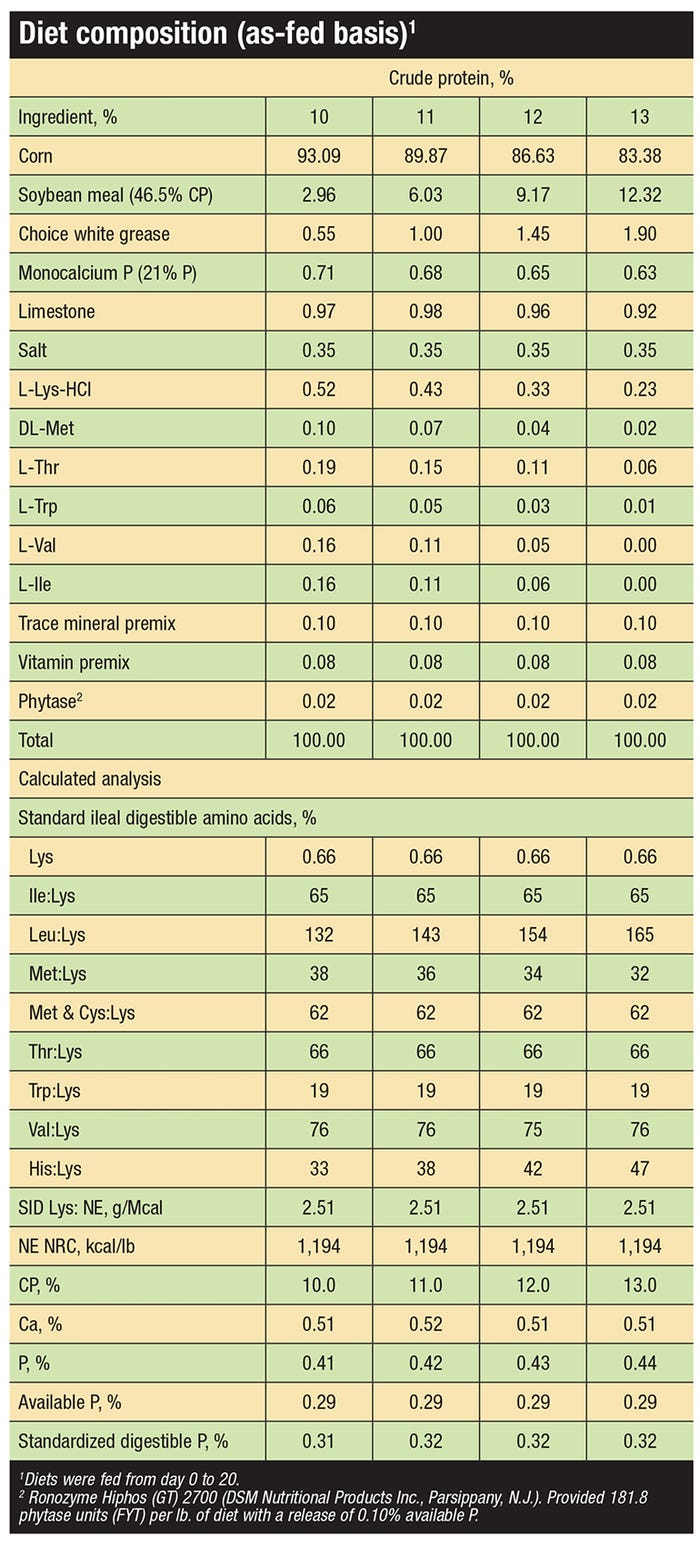Optimum dietary crude protein for average daily gain, average daily feed intake and hot carcass weight average daily gain were reached by pigs fed diets with 12% crude protein.
January 5, 2017

Economic and environmental factors have compelled nutritionists to develop low-protein, amino acid-fortified diets that deliver performance equivalent to traditional formulations.
In some instances, low-protein AA fortified diets have led to poorer performance in finishing pigs than conventional diets. Decreasing dietary protein may compromise pig growth and decrease carcass leanness. One possible explanation for these effects is that the low protein content restricted muscle growth, resulting in a surplus of energy being converted into intramuscular lipids.
Excessive crude protein intake has been shown to increase energy expenditure due to increased nitrogen excretion, as well as impact organ size. Lenis and Jongbloed in 1989 reported that a 1% reduction in dietary crude protein content resulted in an 8.5% reduction in nitrogen excretion.
Previous research has reported no performance effects of lowering crude protein in late-finishing pigs when correct amino acid ratios are met; however, the reduction in crude protein was limited to 12%, or different genetics and body weight range have been used.
Soto et al. this year studied the effects of feeding a 10% or 13% crude protein diet to finishing pigs and found significant performance reduction in pigs fed the diet with 10% crude protein. Overall, there is limited published research available to establish the optimal or minimum dietary crude protein level for late-finishing pigs. Therefore, the objective of the present study is to determine the optimum levels of dietary crude protein for growth performance and carcass characteristics of finishing pigs from 240 to 280 pounds.
A total of 224 pigs, initially weighing 241.1 pounds, were used in a 20-day trial. There were seven pigs per pen (four barrows and three gilts), with a floor space of 8.95 square feet per pig. Pens were equipped with adjustable gates to allow space allowances per pig to be maintained if a pig died or was removed from a pen during the experiment. Pigs were allotted by body weight and randomly assigned to one of four dietary treatments in a completely randomized block design.
The dietary treatments included four crude protein concentrations (10%, 11%, 12% and 13%), with seven replications for the treatment with 10% crude protein and eight replications for the treatments with 11%, 12% and 13% crude protein. Pigs were provided ad libitum access to water and feed in meal form. Prior to the trial, from 200 to 240 pounds, these pigs were fed a corn-soybean meal-based diet with 14.2% crude protein, 0.72 standardized ileal digestible lysine and net energy of 1,150 Kcal per pound.
To formulate the experimental diets, a 13% crude protein corn-soybean meal diet with 0.23% L-lysine hydrogen chloride was formulated. Then L-lysine HCl was included at 0.52%, 0.43% and 0.33% of the diet at the expense of soybean meal to reach the desired levels of 10%, 11% and 12% crude protein, respectively (see table). Diets were isocaloric (NE Kcal/lb. 1,194) with all amino acids at or above minimum ratios relative to lysine.

Pigs were weighed on Day 0, 7, 14 and 20 of the trial to determine average daily gain, average daily feed intake and feed conversion rate. At Day 20, pigs were individually tattooed with a unique identification number to allow for carcass measurements to be recorded on a pig basis. On Day 20, final pen weights and individual weights were taken, and pigs were transported to a commercial packing plant for processing and determination of hot carcass weight (HCW).
Diet samples were taken from six feeders per dietary treatment three days after the beginning and three days before the end of the experiment and stored at -4 degrees F until they were homogenized, subsampled and submitted for analysis of dry matter, crude protein, calcium, phosphorous, ether extract and ash.
Data were analyzed using the PROC GLIMMIX procedure in SAS with pen as the experimental unit and initial body weight as a blocking factor. Dietary treatments were the fixed effect and block served as the random effect in the analysis. Statistical significance was determined at P < 0.05 and marginal differences at P < 0.10.
Results
The analyzed DM, CP, Ca, P, ether extract and ash contents of experimental diets were reasonably consistent with formulated estimates.
For overall growth performance (Day 0 to Day 20), increasing crude protein increased (linear, P < 0.05 and quadratic, P < 0.10) ADG and ADFI with the greatest response for pigs fed the diet with 12% crude protein with little improvement thereafter. In addition, increasing crude protein also improved (linear, P < 0.05) feed efficiency, caloric efficiency, and final body weight.
For carcass characteristics, increasing crude protein increased (linear, P = 0.001 and quadratic, P = 0.07) (HCW) ADG with the greatest response for pigs fed the diet with 12% crude protein. Furthermore, HCW increased (linear, P = 0.040) with increasing dietary crude protein without any influence on carcass yield. Also, HCW feed efficiency and HCW NE caloric efficiency improved (linear, P < 0.050) with increasing crude protein.
In conclusion, the optimum dietary crude protein for ADG, ADFI and HCW ADG were reached by pigs fed diets with 12% crude protein. Further improvement in feed efficiency, HCW, HCW feed efficiency, caloric efficiency and HCW caloric efficiency were observed in pigs fed diet with 13% crude protein.
The F/G improvement in pigs fed the 13% crude protein diet may be due to underestimation of the concentration of NE in soybean meal by National Research Council, as suggested by Sotak-Peper et al. The poorer performance of pigs fed diets with less than 12% crude protein was predominantly explained by reduced feed intake, yet mechanisms underlying regulation of feed consumption when feeding lower crude protein remain unclear.
In addition, it would be possible to hypothesize that reducing crude protein to low levels may result in a deficiency of non-essential amino acids, or other nutrients not provided by low crude protein diets. However, other research has suggested that late-finishing pigs fed low crude protein diets supplemented with non-essential amino acids were not able to overcome the negative impacts on growth performance and carcass characteristics of the low crude protein. Further research is needed to understand the reasons that pigs fed diets with seemingly adequate levels of amino acids, but with less than 12% crude protein, have reduced performance.
Researchers: J.A. Soto, M.D. Tokach, S.S. Dritz, J.C. Woodworth, J.M. DeRouchey and R.D. Goodband, Kansas State University.
You May Also Like



